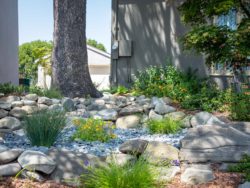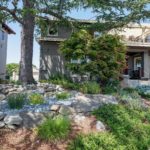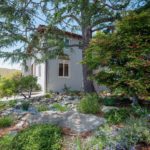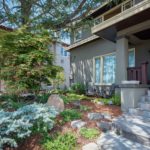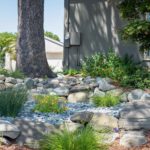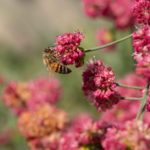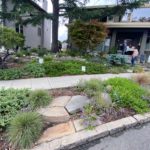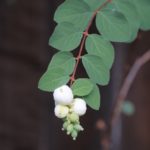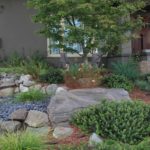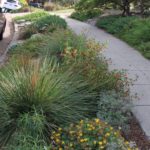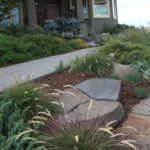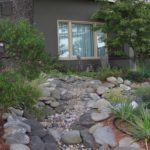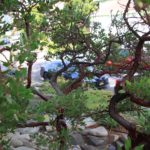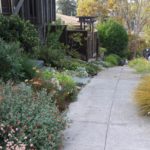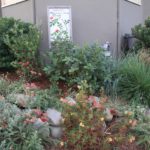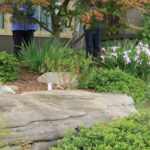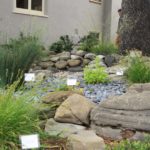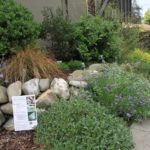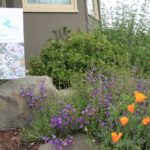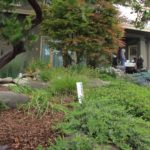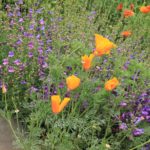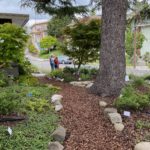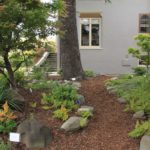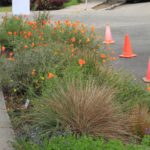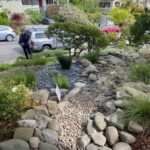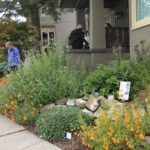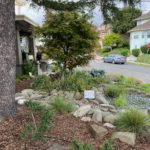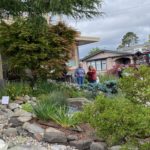Lot size: 2,500 sq. ft. front garden, 90% native
Garden Age: Garden was installed in the fall of 2021 and the spring of 2022
Years on the Bringing Back the Natives Garden Tour: 2
Showcase Feature
Mary Ann and Richard have attended the Tour since its inception in 2005. Over the years they found not only inspiration but also Lois Simonds, owner of Gardening by Nature’s Design, who worked her magic for them, creating a beautiful garden with continuity and coherence, and also a dynamic relationship between the native plants she chose and the stone features—steps, boulders, dry creek bed, and the gently curving dry-stacked retaining walls that flow through the garden.
Eight kinds of manzanita grace the garden, providing structure, year-round greenery, and, with their gorgeous cinnamon-colored bark, a constant source of visual enjoyment. The first of our natives to bloom each year, the manzanitas also delight native bees, when, in winter, they produce lovely pink-to-cream-colored bell-shaped flowers that provide pollen for the bees when they need it.
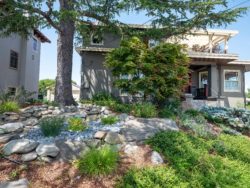 This tranquil, lush garden provides color and interest throughout the year. When the winter display of manzanita blossoms is waning, wildflowers such as buttercups, tidy tips and poppies draw in the butterflies and bees. Their floral show is followed by the cobalt blue blossoms of the California lilac, and the lighter blue flowers of the Winifred Gilman sage (among others!). In late summer pink rosy buckwheat, blue-eyed grass, lavender coyote mint, yellow goldenrod, and bright red fuchsia create a boisterous riot of color that lasts into the fall.
This tranquil, lush garden provides color and interest throughout the year. When the winter display of manzanita blossoms is waning, wildflowers such as buttercups, tidy tips and poppies draw in the butterflies and bees. Their floral show is followed by the cobalt blue blossoms of the California lilac, and the lighter blue flowers of the Winifred Gilman sage (among others!). In late summer pink rosy buckwheat, blue-eyed grass, lavender coyote mint, yellow goldenrod, and bright red fuchsia create a boisterous riot of color that lasts into the fall.
Other Garden Attractions
• Got a parking strip you’d like to transform? If so, you won’t want to miss this one. Note how the plants and stone work in this attractive parking strip echo and complement elements found in the main garden.
• The dry creek bed captures rain water, and retains it in a small wetland. Retaining rainwater on-site keeps the garden green longer, and, as water slowly trickles into the soil, helps to replenish the groundwater.
• A potpourri of evergreen, low-maintenance groundcovers, including prostrate ‘Emerald Carpet’ manzanita, ‘Pigeon Point’ coyote brush, ‘Anchor Bay’ California lilac, and fragrant yerba buena keep the garden looking great all year.
• This garden is open to grazing by deer.
• Designer Lois Simonds will be available throughout the day to answer questions.
Gardening for Wildlife
Berry-bearing native plants, such as currants, coffeeberries, and manzanitas provide food for birds, and water is available in the seasonal wetland.
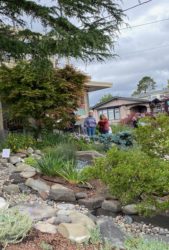 Endangered monarch butterflies lay their eggs on our local native milkweed, Asclepius fascicularis, the only plant monarchs can reproduce on. The bright yellow, black, and white caterpillars can occasionally be seen traveling about the garden, headed toward the Douglas irises, or perhaps a coffeeberry, where they will transform into a chrysalis.
Endangered monarch butterflies lay their eggs on our local native milkweed, Asclepius fascicularis, the only plant monarchs can reproduce on. The bright yellow, black, and white caterpillars can occasionally be seen traveling about the garden, headed toward the Douglas irises, or perhaps a coffeeberry, where they will transform into a chrysalis.
Dark-eyed juncos hop about the garden, searching for insects and seeds. The dark-eyed junco is a once-common backyard bird whose numbers have declined steeply in recent years. As juncos are ground-nesters, the parents and their chicks are easy prey for cats. You can help protect these, and other birds by keeping your cat indoors (or contained), and taking any of these additional steps.
Garden Talks
11:00 “Designing a garden with California native plants and stone: Creating a sense of place and connection” by Lois Simonds
Keystone species (watch this talk by Doug Tallamy!)
Keystone species—our own, local ecological powerhouse plants— in this garden include currants, California lilac, manzanitas, lupines, sages, buckwheats, and goldenrod.
Green Home Features
Mary Ann and Richard have two separate solar panel systems, with a total of 30 panels. The first system was installed in 2016, and the second in 2020. Together they generate 12.5 megawatt hours of energy per year. The energy generated by the solar panels covers all the electricity they use in the house, and also powers two electric vehicles. The newer system can bypass the electrical grid and directly charge the cars in case of a power outage.
Their panels produce most of their electricity between mid-April and mid-September. The credit that Mary Ann and Richard get from PG&E during that time covers their additional power needs during the rest of the year, so the Walsh’s have almost no PG&E bill. (And, of course, as they have electric cars they pay nothing for gasoline.)


